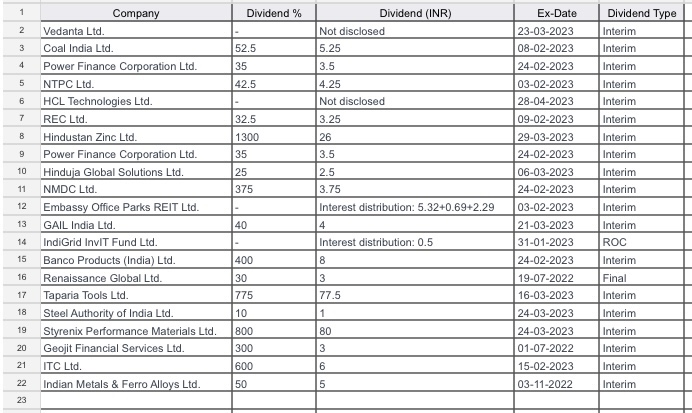
Dividend reinvestment plans (DRIPs) are a popular investment strategy for long-term investors seeking to maximize their returns in the Indian stock market. DRIPs allow shareholders to automatically reinvest their dividend income by purchasing additional shares of the same company, often at a discounted price or with no transaction fees. In this comprehensive guide, we will delve into the nitty-gritty of dividend reinvestment plans in the Indian market, how they work, their benefits and drawbacks, and provide a list of high dividend yield Indian companies that offer DRIPs.
How Dividend Reinvestment Plans Work in India:
Dividend reinvestment plans in India work differently depending on the company’s policy. Some companies offer a direct DRIP, which allows shareholders to automatically reinvest their dividend income in additional shares of the same company without incurring any transaction fees. This is typically done through a separate account maintained by the company’s registrar and transfer agent. Other companies may offer a dividend reinvestment option through a stockbroker or a third-party service provider, which may involve transaction fees or commissions.
To participate in a DRIP, investors need to own shares of the company that offers the plan. When the company declares a dividend, shareholders can choose to opt for the DRIP and indicate the number of shares they wish to reinvest. The company then issues additional shares to the shareholder’s account, either at the current market price or at a discounted price, depending on the company’s policy. The reinvested dividend income is used to purchase these additional shares, which are then credited to the shareholder’s account.
Benefits of Dividend Reinvestment Plans in India: DRIPs offer several benefits for long-term investors in the Indian market:
- Compounding: DRIPs allow investors to benefit from the power of compounding. By reinvesting dividends and purchasing additional shares, investors can compound their returns over time, potentially leading to significant wealth accumulation.
- Cost-effective: DRIPs are often cost-effective as they may involve little or no transaction fees, especially in direct DRIPs offered by companies. This can result in higher returns compared to regular dividend payouts where transaction fees may apply.
- Dollar-cost averaging: DRIPs enable investors to practice dollar-cost averaging, as they automatically invest a fixed amount in additional shares at regular intervals. This strategy can help mitigate the impact of market volatility and reduce the risk of making poor investment decisions based on short-term market fluctuations.
- Tax-efficient: In India, dividend income is subject to dividend distribution tax (DDT) at the company level, resulting in a lower net dividend payout to shareholders. However, under DRIPs, the dividend income is reinvested in additional shares, which may result in a deferred tax liability until the shares are eventually sold. This can provide potential tax benefits for investors.
High Dividend Yield Indian Companies with Dividend Reinvestment Plans:
Here are some high dividend yield Indian companies that offer dividend reinvestment plans:
- Hindustan Petroleum Corporation Limited (HPCL) : HPCL is a leading oil and gas company in India that offers a DRIP to its shareholders. The company has a consistent track record of paying dividends and offers a high dividend yield, making it an attractive option for income-seeking investors.
- Oil and Natural Gas Corporation Limited (ONGC) : ONGC is a state-owned oil and gas exploration and production company in India that also offers a DRIP. The company has a long history of paying dividends and offers a competitive dividend yield, making it a popular choice among dividend investors.
- Power Finance Corporation Limited (PFC) : PFC is a government-owned financial institution in India that provides funding to the power sector. The company offers a DRIP to its shareholders, allowing them to reinvest their dividends in additional shares of the company. PFC has a strong dividend history and offers a relatively high dividend yield, making it an attractive option for dividend-oriented investors.
- Rural Electrification Corporation Limited (REC) : REC is another government-owned financial institution in India that provides funding to the rural electrification sector. The company offers a DRIP to its shareholders, providing them with the option to reinvest their dividends in additional shares of the company. REC has a consistent dividend track record and offers a competitive dividend yield, making it a potential choice for dividend-focused investors.
- Coal India Limited (CIL) :CIL is a state-owned coal mining company in India and is one of the largest coal producers in the world. The company offers a DRIP to its shareholders, allowing them to reinvest their dividends in additional shares of the company. CIL has a history of paying dividends and offers a decent dividend yield, making it a possible choice for dividend-oriented investors.
- Bharat Petroleum Corporation Limited (BPCL) :BPCL is a leading oil and gas company in India that offers a DRIP to its shareholders. The company has a consistent dividend payment history and offers a competitive dividend yield, making it a potential option for income-seeking investors.
Here is a table showcasing some high dividend yield Indian companies and their recent dividend details:

Conclusion:
Dividend reinvestment plans can be a beneficial strategy for long-term investors seeking to maximize their returns in the Indian market. They offer the potential for compounding, cost-effectiveness, dollar-cost averaging, and tax-efficiency. There are several high dividend yield Indian companies that offer DRIPs, including Hindustan Petroleum Corporation Limited, Oil and Natural Gas Corporation Limited, Power Finance Corporation Limited, Rural Electrification Corporation Limited, Coal India Limited, and Bharat Petroleum Corporation Limited. However, it’s important to carefully evaluate each company’s dividend policy, financial health, and overall investment suitability before making any investment decisions. It’s also advisable to consult with a qualified financial professional for personalized investment advice. Happy investing!
Some important FAQs about Dividend:
How Does Taxation of Dividends Work?
Investors with a total income exceeding the basic exemption limit (BEL) are required to file an income tax return. If the income from dividends exceeds INR 5,000 in a financial year and the total income does not exceed BEL, the investor would need to file an income tax return and can claim the deducted tax amount back.
Is It Compulsory For a Company to Give Dividends to Investors?
Companies are not obligated to give dividends to their shareholders. It is solely at the discretion of the board of directors to decide on the amount and frequency of dividend payments. If the board believes that a portion of the profits generated should be shared with the shareholders, they may declare dividends. Otherwise, the profits can be used for other purposes such as expansion, debt payment, or product development.
How Many Times Can a Company Announce a Dividend?
Companies can announce dividends quarterly, monthly, or annually, depending on their choice. Some companies may even pay dividends on a monthly basis. The decision on the frequency of dividend payments is determined by the company’s financial performance, cash flow, and future growth plans.
What is the Ex Date?
The ex-date is the date on or after which a security is traded without a previously declared dividend or distribution. This means that investors who hold the stock before the ex-dividend date and continue to hold it before the market opens on the ex-dividend date will be eligible to receive the dividend, while those who purchase the stock after the ex-dividend date will not be entitled to the dividend.
What is an Interim Dividend?
Interim dividends are dividends paid by a company quarterly or monthly and are not the final dividends. They may be released along with the interim financial statements, but it is not mandatory. Final dividends, on the other hand, are declared after the annual meeting and the release of the yearly financial statements.

1 thought on “The Ultimate Guide to Dividend Reinvestment Plan in the Indian Market”